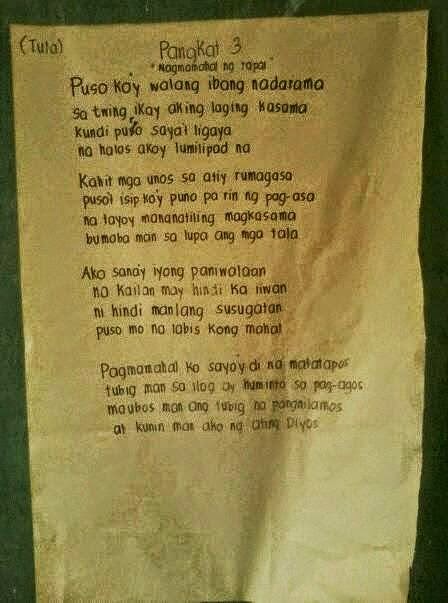Unlocking the Power of the Stanza: A Deep Dive into Filipino Poetry
Have you ever felt the emotional resonance of a perfectly crafted poem? The magic often lies in its structure, specifically the stanza. In Filipino poetry, "ano ang saknong ng tula" translates to "what is a stanza of a poem?" This seemingly simple question opens the door to a world of poetic expression and cultural significance. Understanding the stanza is key to unlocking the full power and beauty of Filipino verse.
A stanza in poetry is like a paragraph in prose. It’s a grouping of lines, typically unified by rhyme or rhythm, that forms a distinct unit within the poem. These poetic "paragraphs" contribute to the overall flow, rhythm, and meaning of the poem. In Filipino poetry, known for its rich history and diverse forms, the stanza plays a crucial role in conveying emotions, narratives, and cultural values. Think of it as the building block of a poem's architecture.
Historically, Filipino poetry, from ancient chants to contemporary spoken word, has relied on the stanza to structure its expressions. Pre-colonial Philippine literature, passed down through oral tradition, often employed rhythmic stanzas in epic narratives and ritualistic chants. The arrival of Spanish influence introduced new poetic forms and structures, further refining the use of the stanza. This evolution continues today, with modern Filipino poets experimenting with diverse stanzaic arrangements, pushing the boundaries of traditional forms.
The stanza’s importance in Filipino poetry is multifaceted. It dictates the poem’s rhythm and flow, influencing how the reader experiences the emotional and narrative arc. A short, abrupt stanza can create a sense of urgency, while a longer, flowing stanza might evoke a feeling of contemplation. Furthermore, the stanza allows poets to control the delivery of their message, emphasizing specific themes or images by isolating them within a stanzaic unit.
One of the main issues surrounding the understanding of the stanza in Filipino poetry is the potential for misinterpretation due to the nuances of translation. While the basic concept remains the same, the cultural context and specific poetic traditions can impact how the stanza is perceived and utilized. Different forms of Filipino poetry, like the tanaga and the dalit, have unique stanzaic structures and rules, adding to the complexity of understanding their construction and significance.
A simple example of a four-line stanza (quatrain) in Filipino poetry could be:
Ang bituin sa langit ay nagniningning, (The stars in the sky are shining)
Nagbibigay liwanag sa dilim ng gabi. (Giving light to the darkness of night)
Tulad ng pag-ibig na walang hanggan, (Like love that is eternal)
Sumisikat sa puso't nagpapasigla. (Shining in the heart and invigorating)
Benefits of understanding stanzaic structure include enhanced appreciation of poetic artistry, improved ability to analyze and interpret poems, and the development of stronger poetic writing skills.
Advantages and Disadvantages of Focusing Heavily on Traditional Stanzaic Structures
| Advantages | Disadvantages |
|---|---|
| Provides a framework for composition | Can feel restrictive to creativity |
| Helps create rhythm and flow | May limit exploration of free verse |
| Connects to historical poetic traditions | Could make poetry feel dated or formulaic |
Best practices for working with stanzas include varying stanza length for effect, using stanzas to emphasize key themes, considering the relationship between stanza breaks and the poem’s overall message, experimenting with different stanzaic forms, and reading poetry widely to learn from established poets.
Frequently Asked Questions:
1. What is the difference between a stanza and a verse? A verse is a single line of a poem, while a stanza is a group of lines.
2. How do I determine the right stanza length for my poem? Experiment and consider the effect you want to create.
3. Are there rules for stanza construction? While some traditional forms have specific rules, many contemporary poets experiment freely.
4. How does the stanza contribute to the meaning of a poem? It shapes the flow, rhythm, and emphasis of the poem.
5. Can a poem have only one stanza? Yes, a single-stanza poem is possible.
6. What is the significance of the stanza break? It creates a pause, allowing the reader to reflect and absorb the previous stanza.
7. How can I improve my understanding of stanzaic structure? Read poetry widely and analyze the stanzaic choices of different poets.
8. Are there different types of stanzas? Yes, there are various types, such as couplets, tercets, quatrains, etc.
Tips and tricks for working with stanzas include reading your poem aloud to hear the rhythm and flow created by the stanza breaks and experimenting with different stanzaic arrangements to see how they impact the overall effect of the poem.
In conclusion, understanding "ano ang saknong ng tula," or the concept of the stanza in Filipino poetry, is essential for appreciating the artistry and depth of this rich literary tradition. From the ancient chants passed down through generations to the contemporary poetry resonating in today's world, the stanza serves as a crucial building block. It shapes the poem's rhythm, emphasizes key themes, and guides the reader's emotional journey. By exploring the nuances of stanzaic structure, we can gain a deeper understanding of Filipino poetry, enriching our appreciation for its beauty and power. Explore the world of Filipino poetry – dive into its stanzas and unlock a universe of meaning and expression. Start reading, analyzing, and even writing your own poetry today, and experience the transformative power of the stanza firsthand. Don't just read poetry; feel it, breathe it, and let it speak to you through its carefully constructed stanzas.
Essay font face off deciphering the default
St johns episcopal church los angeles a legacy in the city of angels
Level up your username the ultimate guide to using symbols















